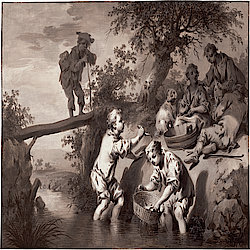Loading the page ...
Johann Conrad Seekatz
1719 Grünstadt – 1768 Darmstadt
Johann Conrad Seekatz came from a family of artists in the Palatinate and began training under his father, who was a court painter in Leiningen-Westerburg. From 1748 to 1752 Seekatz was apprenticed to the Mannheim court painter, Philipp Hieronymus Brinkmann, and then immediately appointed to the court of Landgrave Ludwig VIII in Darmstadt. He started out as second court painter there in 1753 while simultaneously producing works for a broad clientele interested in small, Dutch-style paintings. It was probably during the years he spent in Darmstadt that Seekatz developed a predilection for genre scenes in a still distinctly Rococo spirit. The artist continued to exploit the wide range of opportunities this artistic discipline afforded until the early 1760s and consolidated his reputation in the process. Included in his repertoire were scenes from everyday bourgeois life – realistically portrayed “natural and innocent scenes” incorporating numerous depictions of children, which were praised by Goethe no less, as well as scenes from peasant life.
Archive
